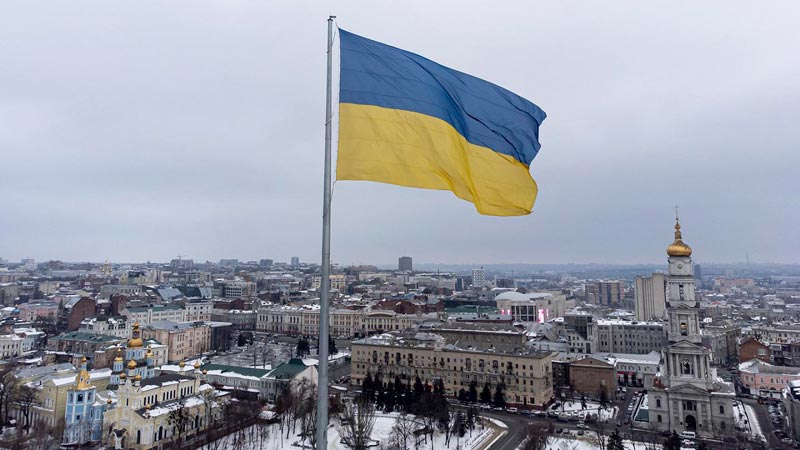
 By Natali Moss
By Natali Moss
Last December, Izvestia published a "scout" evaluation - "minimal losses". At the same time, the losses of the Ukrainian side were estimated at tens of thousands. Surprisingly, given the attempts of the Russian Army to advance, declared mobilization and, after all, the recruitment of prisoners. And also the condition of the fields, for example, under Bakhmut, which are littered with corpses. The Ukrainian side also does not give the number of losses, but it calculates Russian.
According to the General Staff of the Armed Forces of Ukraine, the Russian Federation has lost more than 135,000 people. This theoretically explains the need for mobilization, decrees of Russian dictator Vladimir Putin on the increase in the number of the army mentioned by the Russian "Zecs" on the front. The exact general figures are likely to be obtained only after the war. But in this case, Russian and Ukrainian data will be different.
At least such a picture is observed by most wars and regional conflicts. But there is another aspect that should be taken into account - a regional incision - the features of the subjects of the Federation. And finally, not only absolute digits of losses in the regions, but their share (percentage) from the population of this territory. After all, 100 corpses from the front will not be noticed in the conditional Moscow, and in the city with a population of 100,000 - this is already a large figure.
This is again faced with the absence of numbers. More precisely, their shortages, because in the local Russian press (where it is), obitrologists and materials about the dead are published. Not all, of course, but even tracking such messages gives a number that significantly exceeds the data of the Ministry of Defense of Russia. In addition, in the case of local press monitoring, each "unit" has a name, surname, relatives, burial history. This calculation conducts several organizations.
The Russian BBC and Media Again are offered every month. I used their data in earlier reviews. Then there was a vivid picture - the most massive (in % of the population) losses were in national autonomies and depressive regions with the level of salaries significantly lower than the Central Russian level. And the smallest proportion of losses - in "rich" and developed territories.
Simply put, to die for Putin sent those who had no chance of securing a decent life for his presidency - in present Russia. And the difference % of the dead (from the population) reached 50-60 times. Top-10 "leaders-leaders" of statistics on a loss of losses from September 2022, when he analyzed a regional incision (read here), it took some time. Russia has escaped from the Kherson region and continued to attempt to storm Bakhmut.
There were losses (which only increased), mobilization has passed, ten regions of the Russian Federation, which are leaders in maximum and minimal losses. Let's look more. In September 2020, the Russian Defense Minister showed about 5937 fallen Russians. The verification of the local press then gave the figure in 6424 already buried. And these are those who were written about the media - because not all cases of the funeral of the "black package", which came from the front, fall into the media.
And there may be no local media in some regions (villages, settlements, etc. ). In early February 2023, the number of confirmed funerals in the Russian Federation increased twice-to 12 925 cases. The top 10 regions also changed by the highest number of killed in the war (10,000 inhabitants). And there is a clear boundary between the regions - suppliers of "cannon meat" and the rest. If on average in the Russian Federation the number of buried is 0.
008%, then the leaders of the rating have figures from 0. 02%to 0. 042%. This list, consisting of 11, not 10 areas, has the following form: 1. Tiva (0. 0425% or four confirmed funeral media for every 10,000); 2. Buryatia (0. 04%); 3. Nenets AO (0. 036%); 4. North Ossetia (0. 0277%); 5. Magadan region (0. 0276%); 6. Transbaikal region (0. 0256%); 7. Altai Republic (0. 0244%); 8. Sakhalin region (0. 0242%); 9. Chukotsky AO (0. 024%); 10. Pskov region (0. 022%); 11. Kostroma region (0. 0205%). Next is a significant gap.
To understand the scale of problems in these regions, I emphasize that the average in the Russian Federation is 0. 008%). But the most interesting - in the top ten regions with the least share of losses. The list is: 1. Moscow (0. 0006% or six cases of funeral per million inhabitants (not 10,000)); 2. St. Petersburg (0. 0021%); 3. Tyumen region (0. 0028%); 4. Moscow region (0. 0029%); 5. Khanty-Mansi AO (0. 0037%); 6. Yamalo-Nenets Autonomous District (Yanao) (0. 0047%); 7. Kemerovsk region (0. 0048%); 8.
Kaluga region (0. 005%); 9. Tula region (0. 0059%); 10. Tomsk region (0. 006%). Group features each group has its own peculiarities. The leading regions, as a rule, have an average salary that is significantly lower than the Central Russian level. Unlike the September ranking, there is no longer a "property" gap. The reason - five regions with "northern allowances" came to the rating.
But all of them still have common features-there are only four industrial enterprises in 10 regions in 10 regions, which are up to 250 leaders in the Russian industry. There are no universities in 10 regions from the fifty Russian ones. Simply put, these are either depressive or raw materials (which in terms of socio-economic development can also be attributed to depressive). And most of them are located at a distance from the center. Regions with the least share of losses have more in common.
Each of them is the level of income above the Central Russian indicator. In these regions, at least 30% of Russian industrial potential (up to 250 best) is concentrated. At least 30 universities from fifty Russian leaders are concentrated in these territories. And finally, these are either "capital" areas or key raw areas. At the same time, the difference between the proportion of losses in the war to the population of the Moscow and Tiva region differs 70 times.
The situation will change at the same time some "alignment" of indicators. Regions that were the source of "cannon meat" for war with Ukraine have relatively small reserves of human resources. And an increase in the proportion of losses can cause dissatisfaction with the local level. Even 0. 042% in Tiva means that the war directly affected at least 0. 1% of residents (dead + family). And this is only confirmed by the media. The real figure may be larger.
Given the limited mobilization potential of depressive regions, the Russian Federation is forced to take into the army and residents of other subjects of the federation. The effect is somewhat softened by recruiting prisoners. As well as the active use of the territories of Lugansk and Donetsk regions mobilized with Russia. What Russian statistics will not take into account for a long time. But this resource ends sooner or later.
Therefore, a mobilization has been carried out, which the Kremlin is not simply "can repeat", but also repeat as the disposal of "living power". And the first results of mobilization were already in the statistics for February. For example, the proportion of confirmed deaths in the Magadan region from September 2022 to the end of January 2023 increased 6. 6 times, in Chukotka Upiatero, in the Sverdlovsk region 2. 4 times, in Janao. Thus, the number of funerals on the ground will increase.
The proportion of the died from the number of residents is also. And this figure will begin to be leveled. The exception, of course, will be central and rich regions. After all, for the Kremlin, undesirable problems in the key entities of the federation. Propaganda will work for the rest with a picture of the Great War Against the West and a regime of secrecy, which will sooner or later feel the owners of the local press.










All rights reserved IN-Ukraine.info - 2022